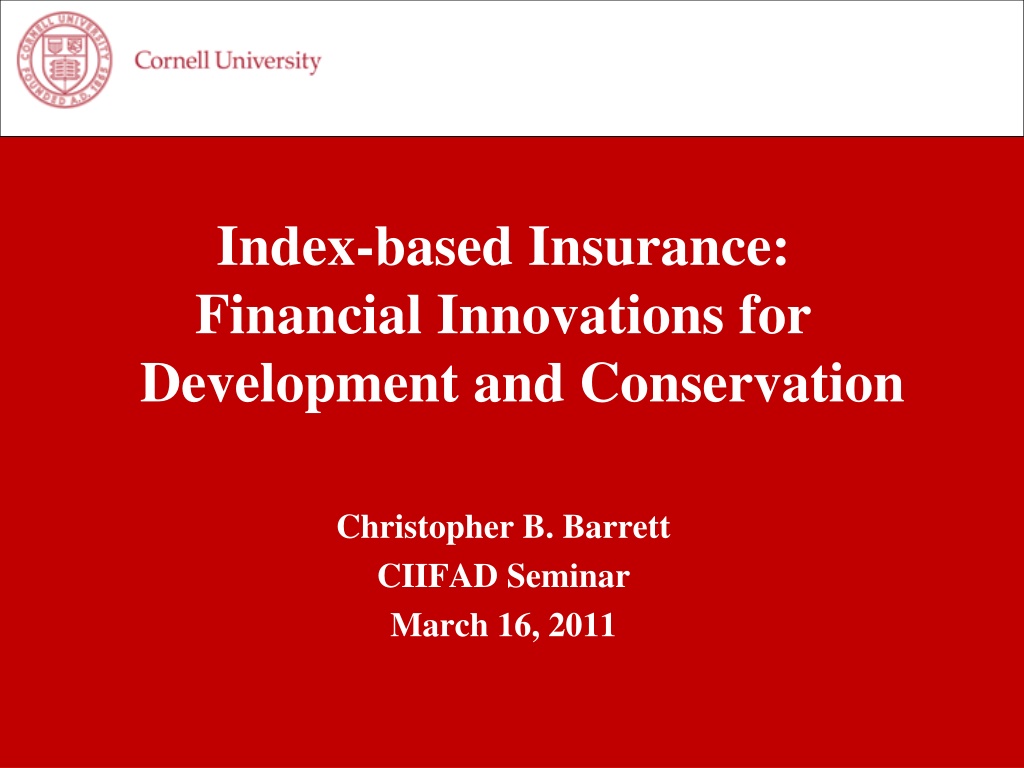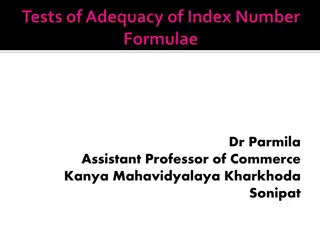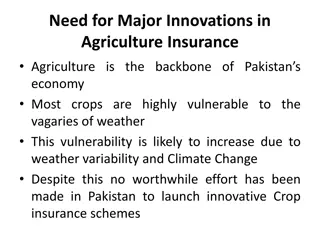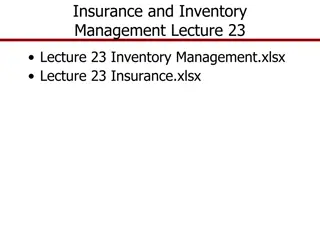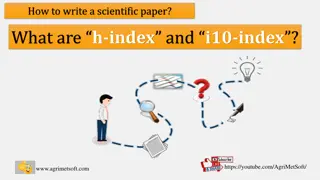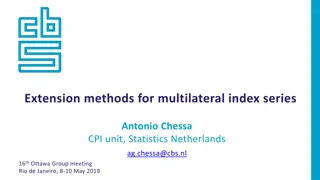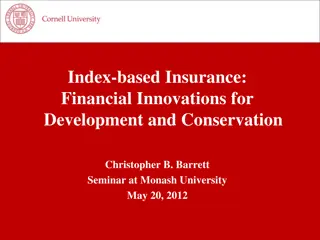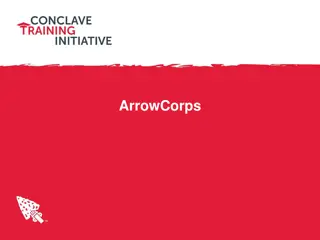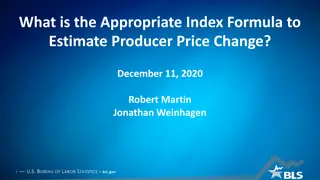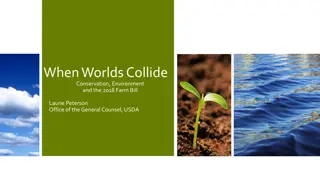Innovations in Index-Based Insurance for Development and Conservation
Explore the potential of index-based insurance as a financial innovation for development and conservation. This type of insurance protects rural livelihoods, prevents poverty, and encourages investment and asset accumulation among the underprivileged. By leveraging objective indices for indemnity payments, index insurance can offer faster and more effective recovery responses. However, the concept also faces challenges such as obtaining high-quality data, minimizing basis risks, incentivizing innovation, creating demand, and ensuring cost-effective delivery mechanisms.
Download Presentation

Please find below an Image/Link to download the presentation.
The content on the website is provided AS IS for your information and personal use only. It may not be sold, licensed, or shared on other websites without obtaining consent from the author. Download presentation by click this link. If you encounter any issues during the download, it is possible that the publisher has removed the file from their server.
E N D
Presentation Transcript
Index-based Insurance: Financial Innovations for Development and Conservation Christopher B. Barrett CIIFAD Seminar March 16, 2011
The Potential of Index-based Insurance Environmental and economic costs of uninsured (weather and natural disaster) risk, especially w/ threshold-based traps Insurance protect rural livelihoods and escape poverty: Provide safety net to prevent collapse of vulnerable populations May encourage investment and asset accumulation by the poor May induce financial deepening by crowding-in credit market and reinforcing social insurance arrangements Insurance pre-finance rapid rehabilitation and recovery: Timely response enhances resilience to shocks and prevent system collapse or reduce the costs of humanitarian response If shocks are strongly linked to livelihood and ecosystem dynamics, insurance for cash-for-conservation work can offer Productive safety net for both people and endangered species
The Potential of Index-based Insurance Conventional insurance unlikely to work due to transaction costs and incentive problems (moral hazard and adverse selection) Index insurance w/ indemnity payments based on an index Objectively verifiable, available at low cost in real time Not manipulable by either party to the contract Strongly correlated with risk being insured No transactions costs of measuring individual losses Preserves incentives (no moral hazard or adverse selection) as insured cannot influence index performance Available on near real-time basis: faster indemnity payment for more effective recovery response Prerequisite: strong correlation established from sufficiently high-quality data of insurable risk (the index)
The Challenges of Index Insurance Big 5 Challenges of Sustainable Index Insurance: 1. High quality data (reliable, timely, non-manipulable, long-term) to calculate premium and to determine payouts 2. Minimize uncovered basis risk through product design 3. Innovation incentives for insurance companies to design and market a new product and global market to support it 4. Establish informed effective demand, especially among a clientele with little experience with any insurance, much less a complex index-based insurance product 5. Low cost delivery mechanism for making insurance available for numerous small and medium scale producers
Solutions to Challenges 1. High quality data: Satellite data (remotely sensed vegetation: NDVI), early warning system data (child MUAC), weather station data 2. Minimize uncovered basis risk: Analysis of household/child/species data to calibrate index 3. Innovation incentives for insurers: Researchers do product design work, develop awareness materials and assist with capacity building 4. Establish informed effective demand: Simulation games with real information & incentives 5. Low cost mechanism: Delivery through commercial partners using ICT
Three Examples 1) Index-based livestock insurance (IBLI) to address poverty traps in east African rangelands 2) Famine insurance to pre-finance humanitarian response to drought in east Africa 3) Cash-for-conservation to address windstorm threats to hornbill conservation in southern Thailand
Example 1: IBLI New commercial IBLI product launched commercially in January 2010 in northern Kenya Based on technical design developed at Cornell, refined and led in the field by the International Livestock Research Institute (ILRI) in collaboration with university and private sector partners. Now being adapted and extended to Ethiopia.
IBLI Product Design Temporal structure of 1-year contract (2 seasonal coverage): Seasonal insurance payment based on mortality index:
IBLI Outreach and M&E Field insurance game to generate informed demand Financial educational tool Learn subjects response to product Build demand for IBLI Integrated long-term survey design for impact evaluation to inform program and policy formation Multi-year HH survey w/encouragement design: study behavioral and welfare impact (incl. in comparison with cash transfers)
Example 2: Famine Insurance Current stage of emergency response 3 - 6 months Time Appeal Seasonal rains fail /EWS alert Aid arrival Assess Goal: Use index insurance to pre-finance effective response to severe droughts Time Seasonal rains fail /EWS alert (triggers insurance payout) Aid arrival Appeal for insurance premiums (insurance payout)
Example 2: Famine Insurance NGO/gov t policy holders choose threshold wasting level, then seasonal rainfall distributions and estimated iso-food insecurity curve jointly price the insurance.
Example 3: Hornbills Conservation in Thailand Budo Su-Ngai Padi National Park (BSNP): Mountainous, tropical rainforest vulnerable to wind storms Home to 6 endangered species of hornbills Nesting season (Feb-Sep) each year Population recruitment relies on (1) Availability of suitable nesting trees - Holding capacity for breeding pairs - Storms key cause of irreversible loss (2) Breeding condition free of disturbance - Key threat: extensive human disturbance (poaching, forest clearance), some induced by coping responses to adverse income shocks as key threat to breeding success
Example 3: Hornbills Conservation in Thailand Home to Muslim minorities (among Thailand s poorest groups): Poverty rates ($1.25/day) ~ 43-89% Forest/rice livelihoods, vulnerable to wind shocks Hornbill research foundation and conservation project (since 1994): Collect annual data on nest and reproduction variables Focus on nest modification and replacement (e.g., artificial nests) Extensive community involvement aiming to reduce human disruptions
Example 3: Hornbills Conservation in Thailand General Framework: Accumulation of nest trees ( t g T + = + 1 1 ( g T t + = + 1 1 ) l t ( , ) ) ) l T t t Irreversible nest tree loss ( ) T ( ) ( ) = + + l t l t * I l t , l l ( , ( ) 0 , l T Max l l t t t t t Effective nest recovery response Hornbill population dynamics ( , 1 1 , + + = t v t t Y s R ( ) 2 1 + = t m B ( t v t t Y s R , 1 1 , + + = ( ) t m B 2 1 + = Wind-based index Insurance for nest tree based on ( ( l Max = ( ) ( ) s t + , , Min b B T Strong winds shock ) + + + 1 1 1 t t t l ( ) t B R ) 1 + R + t + + 1 1 t t ) * ) 0 , l c T ( ) t I I s t I + , , Min b B T + 1 1 t t t Community-based nest recovery program I I B + + 1 1 t t Rural village consumption Reduce human disturbance Induced by adverse Consumption shock ( ) ( ) ) = Y ( = + ( ) y y , Y , , , v t t v t t v t ( ) Y + + * insured t v , y y , ( ) 0 , Y Max l l c , , t v t t v t t i
Example 3: Hornbills Conservation in Thailand How would this insurance work? Conservation project can insures any T nest trees If wind-based nest loss index exceeds strike l*, insurance payout can finance rapid community-based nest replacement (e.g., artificial nests) ( ) ( ) = * * ( ), , ( ) 0 , l l T Max l l c T t t c: total replacement cost per tree nest (artificial nest =$400, installation and annual monitoring by local villager = $600, which goes directly to villager) Total Annual Premium ($) 1 Insured Nest Tree (at c=$1000/nest tree) Fair Annual Premium Rate (% total value of nest tree insured) Frequency of Indemnity Payment: Pr( l( )>l*) Frequency of Correct Indemnity Trigger Decision Strike (l*) 5% 10% 15% 46.7% 20.0% 10.0% 87.5% 93.8% 100.0% 3.5% 1.8% 1.0% $35.0 $18.0 $10.0
Example 3: Simulated Impacts Assume that project insures all nest trees at the beginning of any year t, and that each villager receives $600/12 = $50 for full installation and monitoring of an artificial nest 5% contract reduces pr(flock collapse) below initial size (1096) by from 80% to 60% and eliminate prob. of collapse below 75%. It would reduce poverty headcount ($1.25/day) by 20% Cumulative distributions of 1000 replications of 100-yr simulated dynamics (line= no insurance, dash = 5% strike contract, dot = 15% strike contract)
Conclusions Index-based insurance offers promising new options to develop risk management for conservation and poverty reduction in low-income rural areas underserved by traditional insurance. Key needs going forward: - Good data sources - More discriminating design (basis risk, assets) - Technical capacity dev t among field partners - Competition in reinsurance markets - Public financial education and careful M&E
For more information On the IBLI case: Visit web site: http://www.ilri.org/ibli/ On other index insurance innovations: Visit http://aem.cornell.edu/faculty_sites/cbb2/ and http://i4.ucdavis.edu/ Thank you for your interest and comments!
